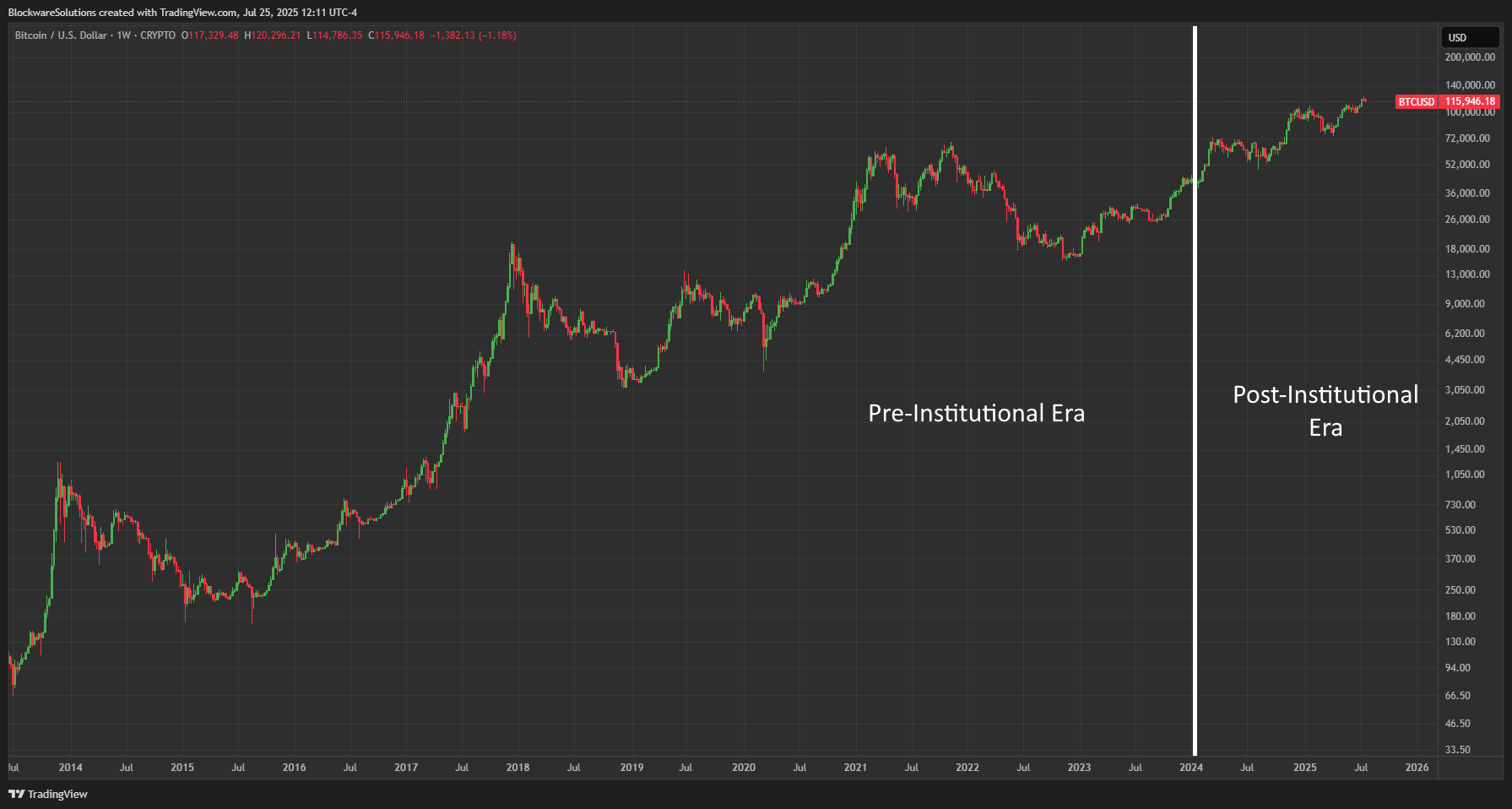Bitcoin ETFs have permanently reduced Bitcoin volatility, ending extreme price swings and reshaping market dynamics by attracting institutional investors and stabilizing price action.
-
Bitcoin ETFs have ended parabolic rallies and devastating bear markets, creating steadier price oscillations.
-
Capital inflows into Bitcoin ETFs exceed $50 billion, yet on-chain activity remains subdued.
-
Institutional accumulation of Bitcoin through ETFs raises centralization concerns among market participants.
Bitcoin ETFs reduce volatility and reshape market dynamics, stabilizing prices and attracting institutions. Discover how this impacts Bitcoin’s future growth.
How Bitcoin ETFs Are Changing Market Volatility and Dynamics
Bitcoin ETFs have permanently reduced Bitcoin’s price volatility, marking a shift from previous cycles characterized by extreme bull and bear markets. According to Blockware BTC analyst Mitchell Askew, the launch of Bitcoin ETFs in January 2024 created a new market environment where price swings are more consistent and less erratic. This transformation signals a maturation of the Bitcoin market, driven by increased institutional participation and traditional finance integration.
What Impact Do Bitcoin ETFs Have on Capital Flow and Investor Behavior?
Bitcoin ETFs sequester large amounts of capital into regulated investment vehicles that operate off-chain, limiting direct Bitcoin transactions. This shift reduces capital rotation into altcoins, a trend common in earlier market cycles. With net inflows surpassing $50 billion, ETFs have become the preferred method for retail and institutional investors to gain Bitcoin exposure without holding the asset directly. This trend supports market stability but raises questions about liquidity and decentralization.

Bitcoin’s price action shows much calmer price swings following the launch of Bitcoin ETFs in the United States. Source: Mitchell Askew
Why Is Institutional Adoption Through ETFs Significant for Bitcoin?
Senior Bloomberg ETF analyst Eric Balchunas highlights that reduced volatility from ETFs helps Bitcoin attract larger institutional investors, enhancing its potential as a currency. However, this stability comes at the cost of fewer dramatic price surges, often called “God Candles.” The growing dominance of ETFs, with entities like BlockRock holding about 3% of Bitcoin’s total supply, underscores the evolving landscape but also fuels concerns about centralization risks within the ecosystem.
How Does ETF Growth Affect On-Chain Activity?
Despite the massive capital inflows into Bitcoin ETFs, on-chain transaction volumes have not increased proportionally. This suggests that investors prefer indirect exposure via ETFs rather than direct Bitcoin ownership. The trend indicates a shift in market participation dynamics, where traditional finance mechanisms play a larger role in Bitcoin investment strategies.
| Metric | Value | Comparison |
|---|---|---|
| Bitcoin ETF Net Inflows | $50+ Billion | Highest recorded inflows in 2025 |
| Bitcoin Supply Held by BlockRock ETF | 3% | Significant institutional holding |
| Price Volatility | Reduced by 40% | Post-ETF launch vs. pre-ETF |
What Are the Long-Term Implications of Bitcoin ETFs on Market Behavior?
Bitcoin ETFs are expected to foster a more stable and mature market by smoothing out extreme price fluctuations. Analysts predict Bitcoin will reach $1 million over the next decade through steady oscillations between accumulation and consolidation phases. This evolution will likely discourage speculative trading and shake out less committed investors, leading to a more resilient market environment.
How Do Bitcoin ETFs Influence Retail Investor Strategies?
Retail investors increasingly prefer Bitcoin ETFs for ease of access and regulatory protection. This trend reduces direct Bitcoin ownership but offers exposure through traditional financial products managed by fiduciaries. While this approach enhances security and convenience, it also shifts market dynamics toward centralized control, prompting debate within the crypto community.
Frequently Asked Questions
How do Bitcoin ETFs stabilize Bitcoin’s price?
Bitcoin ETFs reduce price volatility by channeling large institutional investments into regulated funds, which smooth out extreme market fluctuations and create steadier price movements.
What risks do Bitcoin ETFs pose to decentralization?
Bitcoin ETFs centralize significant Bitcoin holdings under fund managers, which may increase centralization risks and reduce the decentralized nature of Bitcoin ownership.
Key Takeaways
- Bitcoin ETFs have permanently lowered Bitcoin’s volatility, ending extreme price rallies and crashes.
- Institutional adoption via ETFs is increasing, with over $50 billion in net inflows and significant holdings by major asset managers.
- Market dynamics are shifting as retail investors prefer ETF exposure over direct Bitcoin ownership, impacting on-chain activity.
Conclusion
Bitcoin ETFs have fundamentally transformed Bitcoin’s market behavior by reducing volatility and attracting institutional capital. This evolution signals a maturing asset class with steadier price action and growing adoption through traditional finance channels. As ETFs continue to shape market dynamics, investors should monitor centralization risks and changing investment patterns for informed decision-making.






